Design, Analysis of the Location and Materials of Neodymium Magnets on the Torque and Power of In-Wheel External Rotor PMSM for Electric Vehicles
Abstract
:1. Introduction
2. Motor Design Considerations
2.1. Identification of Vehicle Parameters
2.2. Analysis and Selection of Windings for ERPMSM
2.3. Selection of ERPMSM Geometric Dimensions
2.4. Selection of the Shape and Geometric Dimensions of Magnets
2.5. Analysis and Selection of Magnet Fixings on the Rotor
3. Motor Modeling
4. Results of Simulation Research
5. Discussion
6. Conclusions
Funding
Acknowledgments
Conflicts of Interest
References
- Ren, B.; Chen, H.; Zhao, H.; Yuan, L. MPC-based yaw stability control in in-wheel-motored EV via active front steering and motor torque distribution. Mechatronics 2016, 38, 103–114. [Google Scholar] [CrossRef]
- Cao, Y.; Zhai, L.; Sun, T.; Gu, H. Straight Running Stability Control Based on Optimal Torque Distribution for a Four in-wheel Motor Drive Electric Vehicle. Energy Procedia 2017, 105, 2825–2830. [Google Scholar] [CrossRef]
- Liu, M.; Huang, J.; Chao, M. Multi-states Combination Nonlinear Control of In-wheel-motor-drive Vehicle Dynamics Stability. Energy Procedia 2017, 105, 2746–2752. [Google Scholar] [CrossRef]
- Zhang, H.; Zhao, W. Decoupling control of steering and driving system for in-wheel-motor-drive electric vehicle. Mech. Syst. Signal Process. 2018, 101, 389–404. [Google Scholar] [CrossRef]
- Mihály, A.; Gáspár, P.; Németh, B. Multiple fault-tolerant in-wheel vehicle control based on high-level control reconfiguration. IFAC-PapersOnLine 2017, 50, 8606–8611. [Google Scholar] [CrossRef]
- Zeng, X.; Li, G.; Yin, G.; Song, D.; Li, S.; Yang, N. Model predictive control-based dynamic coordinate strategy for hydraulic hub-motor auxiliary system of a heavy commercial vehicle. Mech. Syst. Signal Process. 2018, 101, 97–120. [Google Scholar] [CrossRef]
- Wang, Z.; Wang, Y.; Gao, Z.; Guo, J. Torque Distribution Control Strategy based on Dynamic Axle Load for 8 In-Wheel Motor Drive Vehicle. Energy Procedia 2016, 104, 550–555. [Google Scholar]
- Bauer, P.; Kazmierkowski, M.P.; Strzelecki, R. Multilevel Converters. Bull. Pol. Acad. Sci. Tech. Sci. 2017, 65, 563–565. [Google Scholar] [CrossRef] [Green Version]
- Wang, B.; Huang, X.; Wang, J.; Guo, X.; Zhu, X. A robust wheel slip control design for in-wheel-motor-driven electric vehicles with hydraulic and regenerative braking systems. In Proceedings of the American Control Conference (ACC), Portland, OR, USA, 4–6 June 2014; pp. 3225–3230. [Google Scholar]
- Le Solliec, G.; Chasse, A.; Geamanu, M. Regenerative braking optimization and wheel slip control for a vehicle with in-wheel motors. IFAC Proc. Vol. 2013, 30, 542–547. [Google Scholar] [CrossRef]
- Rahim, N.; Ping, H.; Tadjuddin, M. Design of an in-wheel axial flux brushless dc motor for electric vehicle. In Proceedings of the 2006 International Forum on Strategic Technology, Ulsan, Korea, 18–20 October 2006; pp. 16–19. [Google Scholar]
- Shin, P.S.; Kim, H.D.; Chung, G.B.; Yoon, H.S.; Park, G.S.; Koh, C.S. Shape Optimization of a Large-Scale BLDC Motor Using an Adaptive RSM Utilizing Design Sensitivity Analysis. IEEE Trans. Magn. 2007, 43, 1653–1656. [Google Scholar] [CrossRef]
- Seo, I.M.; Kim, H.K.; Hur, J. Design and analysis of modified spoke type BLDC motor using a ferrite permanent-magnet. In Proceedings of the 17th International Conference on Electrical Machines and Systems (ICEMS), Hangzhou, China, 22–25 October 2014; pp. 1701–1705. [Google Scholar]
- Zhu, J.; Cheng, K.E.; Xue, X.; Zou, Y. Design of a novel high-torque-density in-wheel switched reluctance motor for electric vehicles. In Proceedings of the 2017 IEEE International Magnetics Conference (INTERMAG), Dublin, Ireland, 24–28 April 2017; pp. 1–2. [Google Scholar]
- Oksuztepe, E. In-Wheel Switched Reluctance Motor Design for Electric Vehicles by Using a Pareto-Based Multiobjective Differential Evolution Algorithm. IEEE Trans. Veh. Technol. 2017, 66, 4706–4715. [Google Scholar] [CrossRef]
- Artetxe, G.; Paredes, J.; Prieto, B.; Martinez-Iturralde, M.; Elosegui, I. Optimal pole number and winding designs for low speed–high torque synchronous reluctance machines. Energies 2018, 11, 128. [Google Scholar] [CrossRef]
- Song, J.H.; Kim, K.H. A Practical Approach to Localize Simultaneous Triple Open-Switches for a PWM Inverter-Fed Permanent Magnet Synchronous Machine Drive System. Energies 2018, 11, 101. [Google Scholar] [CrossRef]
- Zhu, X.; Shu, Z.; Quan, L.; Xiang, Z.; Pan, X. Design and Multicondition Comparison of Two Outer-Rotor Flux-Switching Permanent-Magnet Motors for In-Wheel Traction Applications. IEEE Trans. Ind. Electron. 2017, 64, 6137–6148. [Google Scholar] [CrossRef]
- Jerome, C.; Philippe, V. Synthesis of high performance PM motors with concentrated windings. IEEE Trans. Energy Convers. 2002, 17, 248–253. [Google Scholar]
- Cote, O.; Chebak, A.; Methot, J.F. Design and Optimization of a high torque in-wheel surface-mounted PM synchronous motor using concentrated winding. In Proceedings of the IEEE International Electric Machines & Drives Conference (IEMDC), Chicago, IL, USA, 12–15 May 2013; pp. 863–870. [Google Scholar]
- Uygun, D.; Bal, G.; Solmaz, S. Design, Analysis and Prototyping of a 6 kW High Torque In-wheel On-drum BLDC Electric Motor for Automotive Applications. In Proceedings of the 3rd International Conference on Information Processing and Electrical Engineering (ICIPEE 2014), Tebessa, Algeria, 16–24 November 2014. [Google Scholar]
- Yang, Y.; Shih, G. Optimal design of an axial-flux permanent-magnet motor for an electric vehicle based on driving scenarios. Energies 2016, 9, 285. [Google Scholar] [CrossRef]
- Hejra, M.; Mansouri, A.; Trabeisi, H. Optimal design of a permanent magnet synchronous motor: Application of in-wheel motor. In Proceedings of the 5th International Renewable Energy Congress (IREC), Hammamet, Tunisia, 25–27 March 2014; pp. 1–5. [Google Scholar]
- Barré, O.; Napame, B. Concentrated windings in compact permanent magnet synchronous generators: managing efficiency. Machines 2016, 4, 2. [Google Scholar] [CrossRef]
- Szeląg, W.; Jędryczka, C. Analysis of multiphase synchronous machines with fractional slot concentrated windings. Comput. Appl. Electr. Eng. 2016, 14, 231–244. [Google Scholar]
- Guo, Q.; Zhang, C.; Li, L.; Gerada, D.; Zhang, J.; Wang, M. Design and implementation of a loss optimization control for electric vehicle in-wheel permanent-magnet synchronous motor direct drive system. Appl. Energy 2017, 204, 1317–1332. [Google Scholar] [CrossRef] [Green Version]
- Rechkemmer, S.K.; Zhang, W.; Sawodny, O. Modeling of a Permanent Magnet Synchronous Motor of an E-Scooter for Simulation with Battery Aging Model. IFAC-PapersOnLine 2017, 50, 4769–4774. [Google Scholar] [CrossRef]
- Guo, Q.; Zhang, C.; Li, L.; Zhang, J.; Wang, M. Design and Implementation of a Loss Optimization Control for Electric Vehicle In-Wheel Permanent-Magnet Synchronous Motor Direct Drive System. Energy Procedia 2017, 105, 2253–2259. [Google Scholar] [CrossRef]
- Zhang, C.; Guo, Q.; Li, L.; Wang, M.; Wang, T. System Efficiency Improvement for Electric Vehicles Adopting a Permanent Magnet Synchronous Motor Direct Drive System. Energies 2017, 10, 2030. [Google Scholar] [CrossRef]
- Gao, P.; Gu, Y.; Wang, X. The Design of a Permanent Magnet In-Wheel Motor with Dual-Stator and Dual-Field-Excitation Used in Electric Vehicles. Energies 2018, 11, 424. [Google Scholar] [CrossRef]
- Liu, C.; Lu, J.; Wang, Y.; Lei, G.; Zhu, J.; Guo, Y. Techniques for Reduction of the Cogging Torque in Claw Pole Machines with SMC Cores. Energies 2017, 10, 1541. [Google Scholar] [CrossRef]
- Peng, M.-T.; Flack, T.J. Design and analysis of an in-wheel motor with hybrid pole–slot combinations. IEEE Trans. Magn. 2016, 52, 1–8. [Google Scholar] [CrossRef]
- Sone, K.; Takemoto, M.; Ogasawara, S.; Takezaki, K.; Akiyama, H. A ferrite PM in-wheel motor without rare earth materials for electric city commuters. IEEE Trans. Magn. 2012, 48, 2961–2964. [Google Scholar] [CrossRef]
- Anvari, B.; Toliyat, H.A.; Fahimi, B. simultaneous optimization of geometry and firing angles for in-wheel switched reluctance motor drive. IEEE Trans. Transp. Electrific. 2018, 4, 322–329. [Google Scholar] [CrossRef]
- Lovatt, H.C.; Elton, D.; Cahill, L.; Huynh, D.H.; Stumpf, A.; Kulkarni, A.; Kapoor, A.; Ektesabi, M.; Mazumder, H.; Dittmar, T.; et al. Design procedure for low cost, low mass, direct drive, in-wheel motor drivetrains for electric and hybrid vehicles. In Proceedings of the 37th Annual Conference of the IEEE Industrial Electronics Society, Crown Conference Centre, Melbourne, Australia, 7–10 November 2011; pp. 4558–4562. [Google Scholar]
- Winter, O.; Ucsnik, S.; Rudolph, M.; Kral, C.; Schmidt, E. Ironless in-wheel hub motor design by using multi-domain finite element analyses. In Proceedings of the International Symposium on Power Electronics, Electrical Drives, Automation and Motion (SPEEDAM), Sorrento, Italy, 20–22 June 2012; pp. 1474–1478. [Google Scholar]
- Yoo, C.-H.; Lim, D.-K.; Woo, D.-K.; Choi, J.-H.; Ro, J.-S.; Jung, H.-K. A New Multimodal Optimization Algorithm for the Design of In-Wheel Motors. IEEE Trans. Magn. 2015, 51, 1–4. [Google Scholar]
- Mai, H.C.M.; Dubas, F.; Chamagne, D.; Espanet, C. Optimal design of a surface mounted permanent magnet in-wheel motor for an urban hybrid vehicle. In Proceedings of the 2009 IEEE Vehicle Power and Propulsion Conference (VPPC), Dearborn, MI, USA, 7–10 October 2009; pp. 481–485. [Google Scholar]
- Shin, D.J.; Kwon, B.J. Multi-objective optimal design for in-wheel permanent magnet synchronous motor. In Proceedings of the ICEMS 2009, The 12th International Conference on Electrical Machines and Systems, Tokyo, Japan, 15–18 November 2009; pp. 1–5. [Google Scholar]
- Li, Z.; Miotto, A. Concentrated-winding fractional-slot synchronous surface PM motor design based on efficiency map for in-wheel application of electric vehicle. In Proceedings of the Vehicle Power and Propulsion Conference (VPPC), Chicago, IL, USA, 6–9 September 2011; pp. 1–8. [Google Scholar]
- Fan, Y.; Zhang, L.; Huang, J.; Han, X. Design, Analysis, and Sensorless Control of a Self-Decelerating Permanent-Magnet In-Wheel Motor. IEEE Trans. Ind. Electron. 2014, 61, 5788–5797. [Google Scholar]
- Tang, Y.; Paulides, J.J.H.; Lomonova, E.A. Automated Design of DC-Excited Flux-Switching In-Wheel Motor Using Magnetic Equivalent Circuits. IEEE Trans. Magn. 2015, 51, 1–11. [Google Scholar] [CrossRef]
- Wang, J.; Zhang, X.; Kang, D. Parameters design and speed control of a solar race car with in-wheel motor. In Proceedings of the IEEE Transportation Electrification Conference and Expo (ITEC), Dearborn, MI, USA, 15–18 June 2014; pp. 1–6. [Google Scholar]
- Song, L.; Li, Z.; Cui, Z.; Yang, G. Efficiency map calculation for surface-mounted permanent-magnet in-wheel motor based on design parameters and control strategy. In Proceedings of the 2014 IEEE Conference and Expo Transportation Electrification Asia-Pacific (ITEC Asia-Pacific), Beijing, China, 31 August–3 September 2014; pp. 1–6. [Google Scholar]
- Kie, Y.J.; Sung, K.K. Method for Fixing Permanent Magnets of Rotor. U.S. Patent 9,917,493B2, 13 March 2018. [Google Scholar]
- Kim, K.; Cho, H.; Moon, S.; Shik, J.; Chae, C.W. Rotor Fixing Unit for Drive Motor. U.S. Patent 9,356,482B2, 31 May 2016. [Google Scholar]
- Wang, J.; Yang, S.; Ye, D. External-Rotor Permanent Magnet Synchronous Motor. C.N. Patent 201,520,094,372, 10 February 2015. [Google Scholar]
- Marchitto, L.; Re, N. Permanent Magnet Rotor. U.S. Patent 8,593,027B2, 26 November 2013. [Google Scholar]
- Shig, T.; Hattori, M. Rotor for Permanent Magnet Motor of Outer Rotor Type. U.S. Patent 20,060,103,253A1, 18 May 2006. [Google Scholar]
- Cleveland, A.M. Electric Motor with Halbach Arrays. U.S. Patent 7,598,646B2, 6 October 2009. [Google Scholar]
- Beniakar, M.E.; Kakosimos, P.E.; Kladas, A.G. Strength pareto evolutionary optimization of an in-wheel pm motor with unequal teeth for electric traction. IEEE Trans. Magn. 2015, 51, 1–4. [Google Scholar] [CrossRef]
- Friedrich, L.A.J.; Bastiaens, K.; Gysen, B.L.J.; Krop, D.C.J.; Lomonova, E.A. Design of an axial-flux permanent magnet machine for a solar-powered electric vehicle. In Proceedings of the 2018 Thirteenth International Conference on Ecological Vehicles and Renewable Energies (EVER), Monte-Carlo, Morocco, 10–12 April 2018; pp. 1–5. [Google Scholar]
- Lassaad, Z.; Ali, M.; Hafedh, T. PSO-based optimal design of in-wheel permanent magnet motor. In Proceedings of the 2017 International Conference on Internet of Things, Embedded Systems and Communications (IINTEC), Gafsa, Tunisia, 20–22 October 2017; pp. 189–194. [Google Scholar]
- Lassaad, Z.; Ali, M.; Hafedh, T. Particle swarm-based optimization of an in wheel permanent magnet motor. In Proceedings of the 2017 14th International Multi-Conference on Systems, Signals & Devices (SSD), Marrakech, Morocco, 28–31 March 2017; pp. 138–144. [Google Scholar]
- Anvari, B.; Toliyat, H.A. Simultaneous optimization of geometry and firing angles of in-wheel switched reluctance motor. In Proceedings of the ECCE 2017, IEEE Energy Conversion Congress & Expo, Cincinnati, OH, USA, 1–5 October 2017; pp. 760–767. [Google Scholar]
- Msaddek, H.; Mansouri, A.; Brisset, S.; Trabelsi, H. Design and optimization of PMSM with outer rotor for electric vehicle. In Proceedings of the International Multi-Conference on Systems, Signals and Devices 2015, Mahdia, Tunisia, 16–19 March 2015; pp. 1–6. [Google Scholar]
- Hong, D.K.; Hwang, W.; Lee, J.Y.; Woo, B.C. Design, Analysis, and Experimental Validation of a Permanent Magnet Synchronous Motor for Articulated Robot Applications. IEEE Trans. Magn. 2018, 54, 1–4. [Google Scholar] [CrossRef]
- Skaar, S.E.; Krøvel, Ø.; Nilssen, R. Distribution, coil-span and winding factors for pm machines with concentrated windings. In Proceedings of the 17th Conference on Electrical Machines (ICEM), Chania, Greece, 2–5 September 2006. [Google Scholar]
- Magnussen, F.; Sadarangani, C. Winding factors and Joule losses of permanent magnet machines with concentrated windings. In Proceedings of the IEMDC 03. International Electric Machines & Drives Conference, Madison, WI, USA, 1–4 June 2003; pp. 333–339. [Google Scholar]
- Łebkowski, A. A way of neodymium-iron-boron magnets regeneration in surface-mounted PMSM used in electric vehicles. Bull. Pol. Acad. Sci. Tech. Sci. 2017, 65, 751–758. [Google Scholar] [CrossRef] [Green Version]
- Kuptsov, V. MotorAnalysis––PM Design and analysis of Permanent Magnet Machines. Available online: http://motoranalysis.com/ (accessed on 2 June 2018).
- Grzesiak, L.; Ufnalski, B.; Kaszewski, A. Control of Electric Drives: Analysis, Modeling, Design; Polish Scientific Publishers PWN: Warsaw, Poland, 2016; ISBN 978-83-01-18318-9. [Google Scholar]
- Koczara, W. Introduction to the Electric Drive; Warsaw University of Technology Publishing House; Warsaw University of Technology: Warsaw, Poland, 2012. [Google Scholar]
- Karyś, S. Advanced control and design methods of the auxiliary resonant commutated pole inverter. Bull. Pol. Acad. Sci. Tech. Sci. 2015, 63, 489–494. [Google Scholar] [CrossRef] [Green Version]
- Huang, Y.; Zhu, Z.; Guo, B.; Lin, H.; Fang, S. Design and thermal analysis on high torque low speed fractional-slot concentrated windings in-wheel traction motor. In Proceedings of the 2016 XXII International Conference on Electrical Machines (ICEM), SwissTech Convention Center, Lausanne, Switzerland, 4–7 September 2016; pp. 1487–1492. [Google Scholar]
- Kim, B. Investigation on Slot–Pole Combinations of a PM Vernier Motor with Fractional-Slot Concentrated Winding Configurations. Energies 2017, 10, 1310. [Google Scholar] [CrossRef]
- Lu, J.; Hu, Y.; Zhang, X.; Wang, Z.; Liu, J.; Gan, C. High-frequency voltage injection sensorless control technique for ipmsms fed by a three-phase four-switch inverter with a single current sensor. IEEE/ASME Trans. Mechatron. 2018, 23, 758–768. [Google Scholar] [CrossRef]
- Lu, J.; Zhang, X.; Hu, Y.; Liu, J.; Gan, C.; Wang, Z. Independent phase current reconstruction strategy for ipmsm sensorless control without using null switching states. IEEE Trans. Ind. Electron. 2018, 65, 4492–4502. [Google Scholar] [CrossRef]
- Wang, Z.; Wang, X.; Cheng, M.; Hu, Y. Comprehensive investigation on remedial operation of switch faults for dual three-phase PMSM drives fed by T-3L inverters. IEEE Trans. Ind. Electron. 2018, 65, 4574–4587. [Google Scholar] [CrossRef]
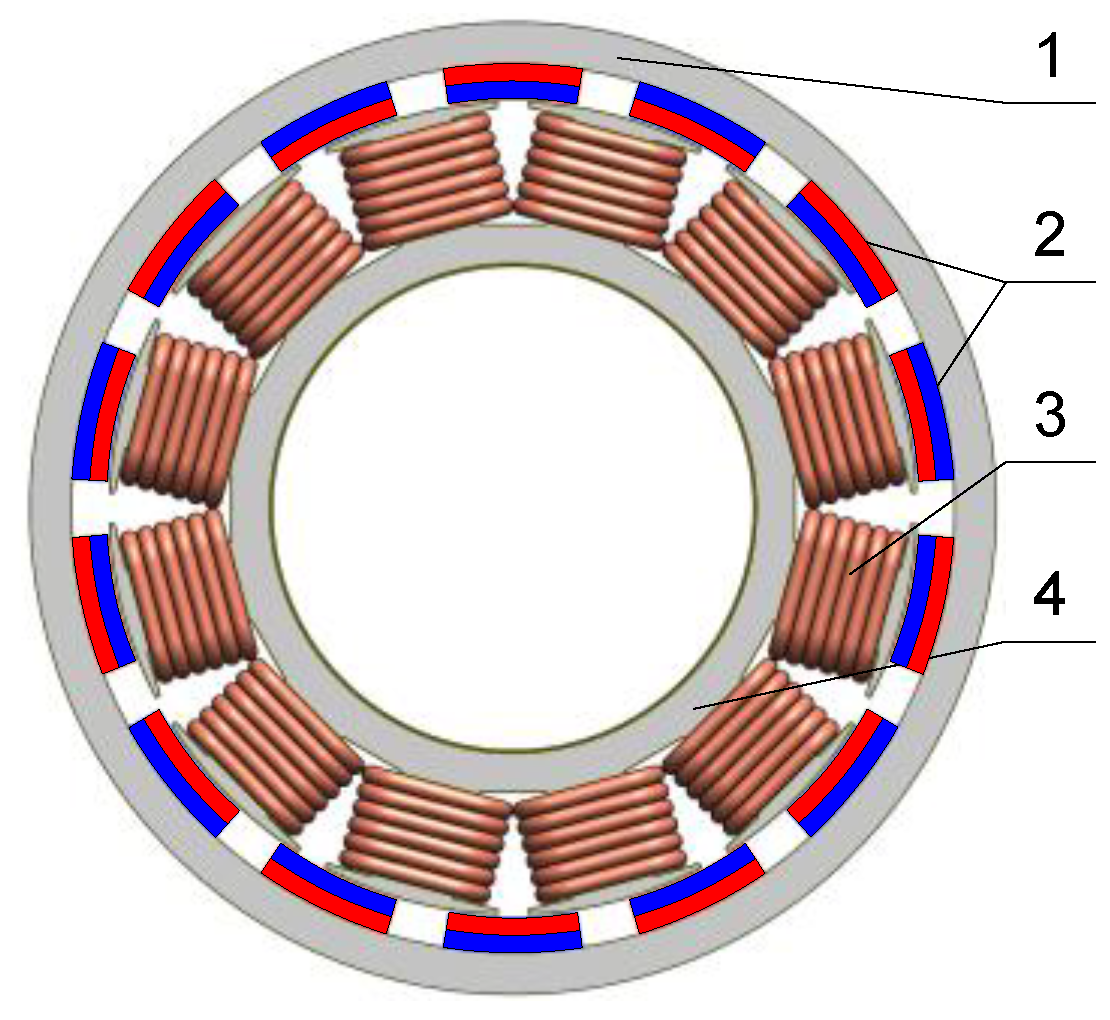

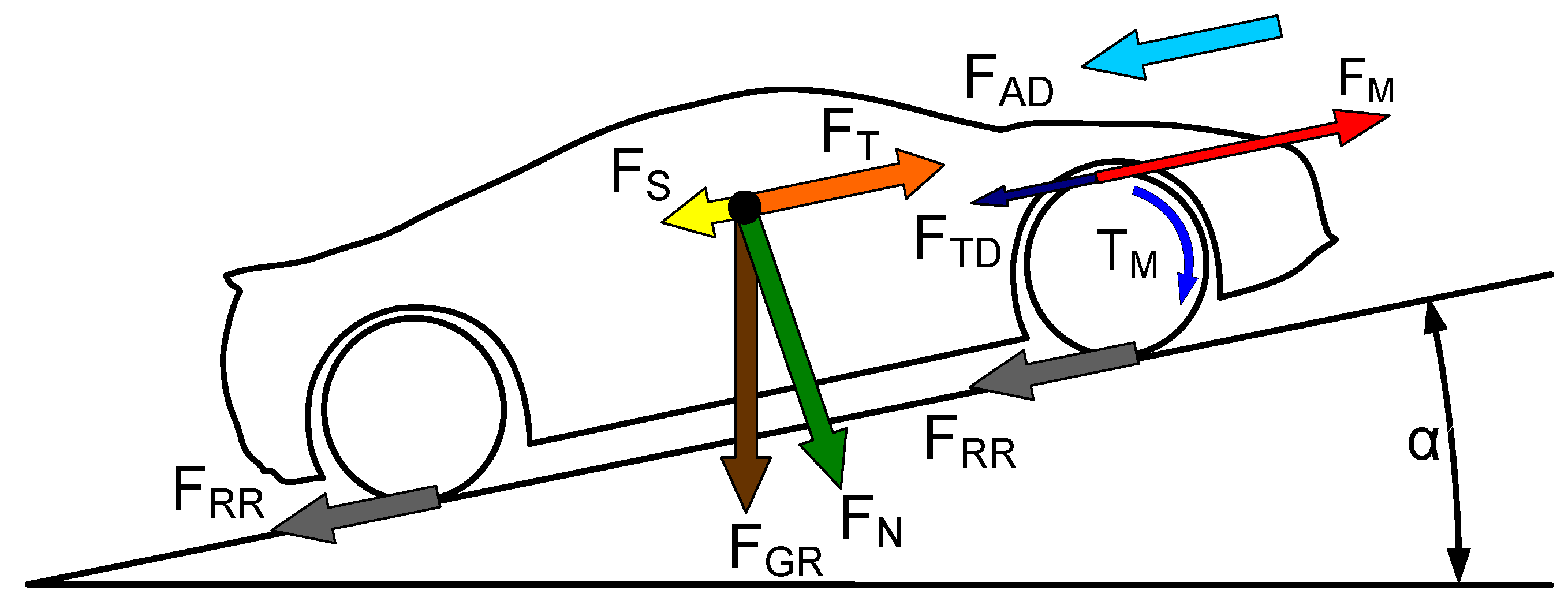
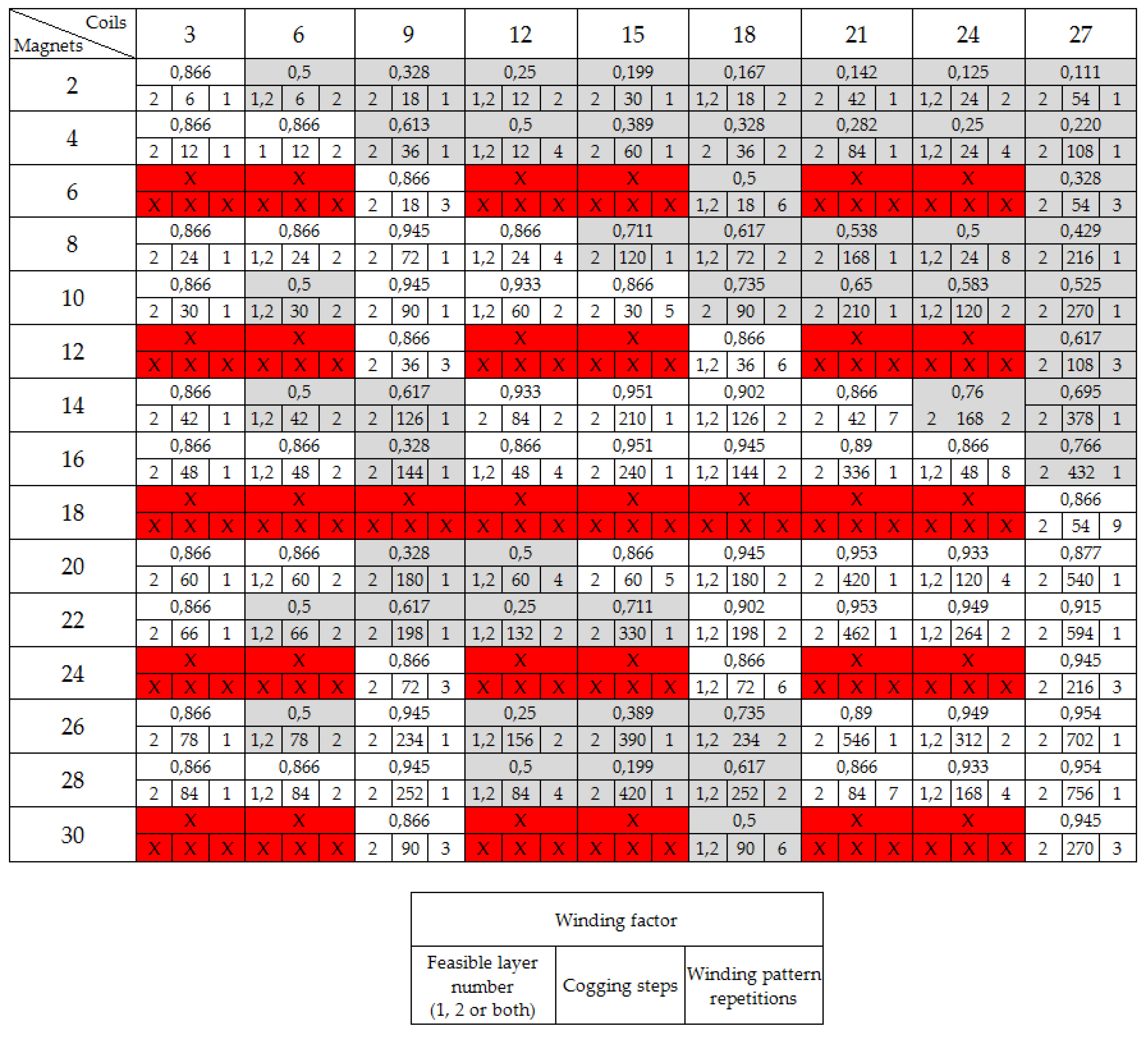
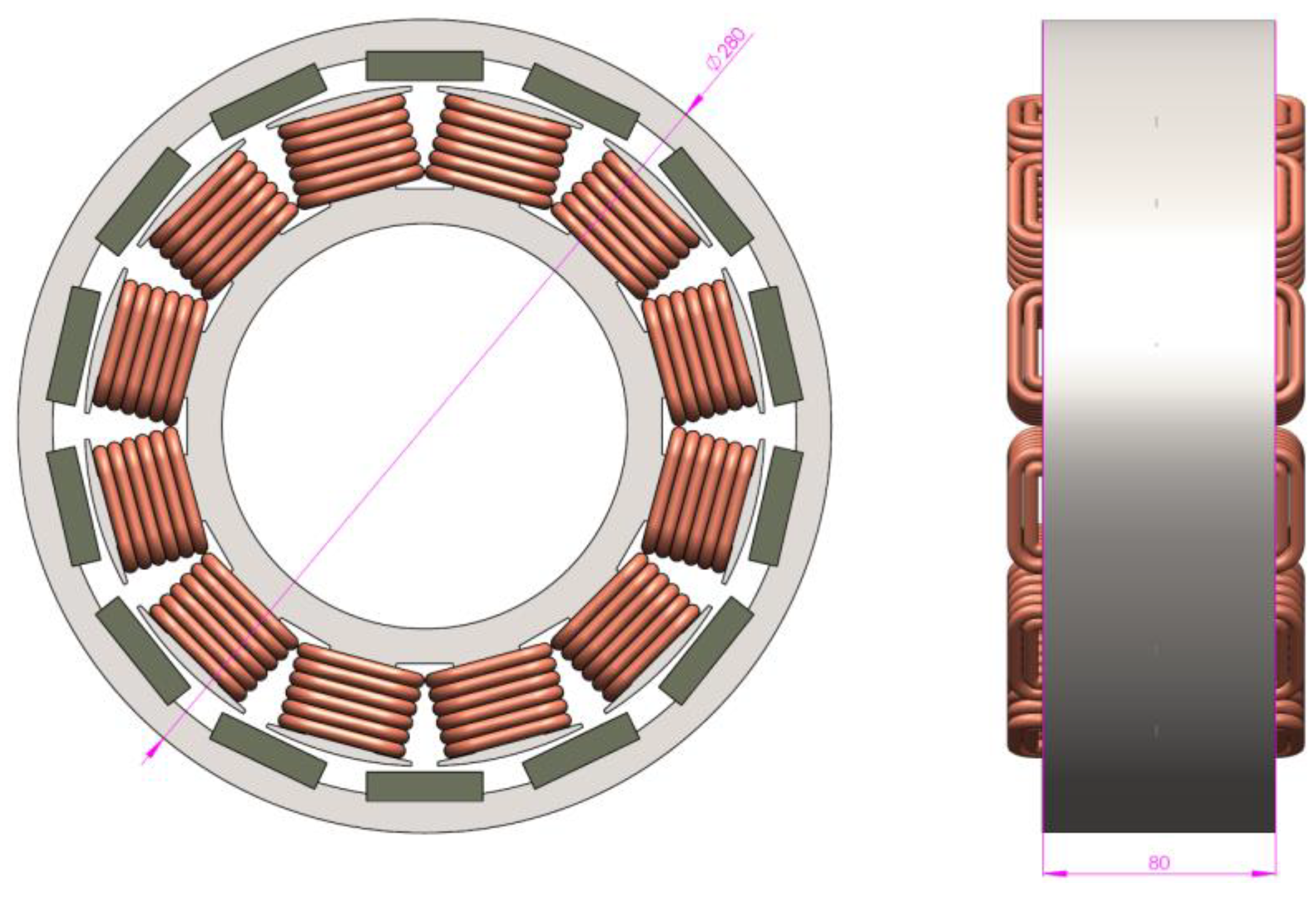

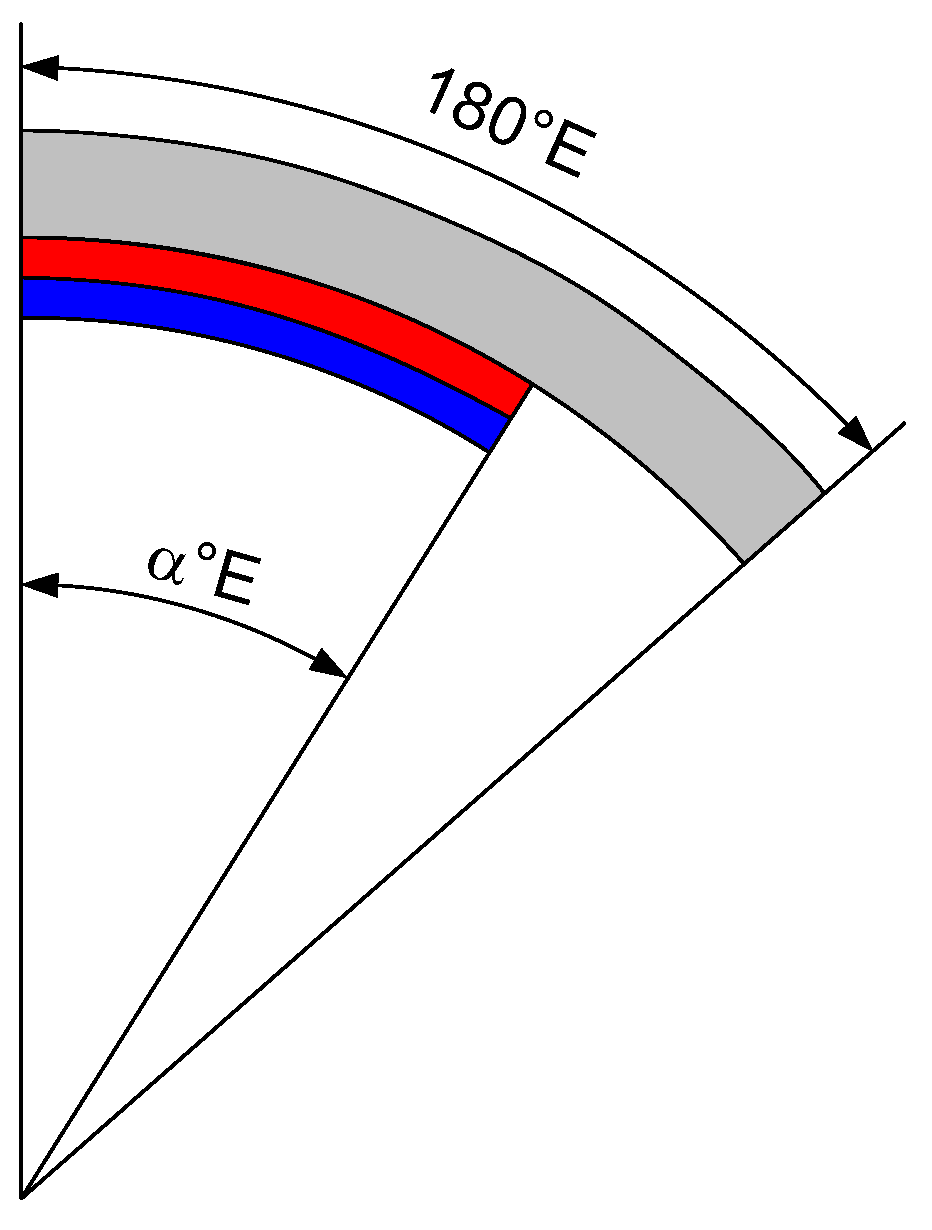
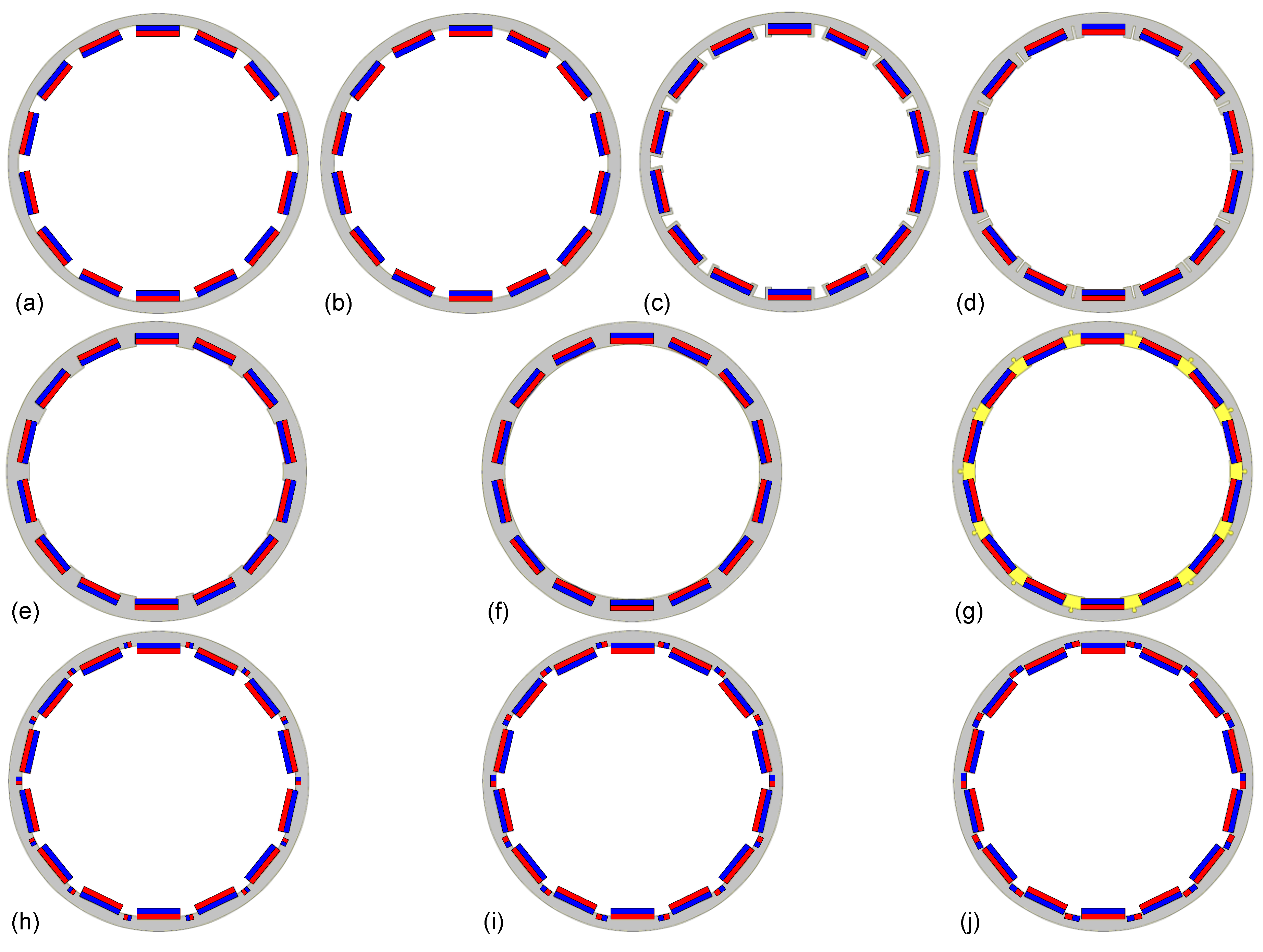
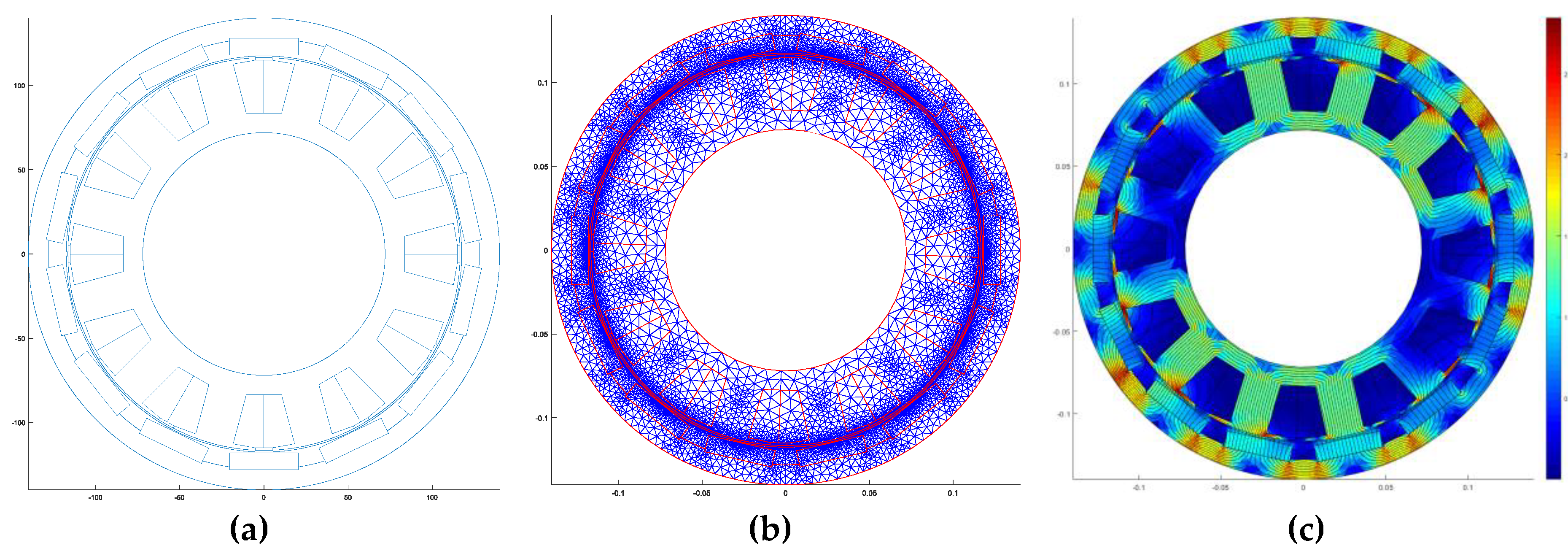
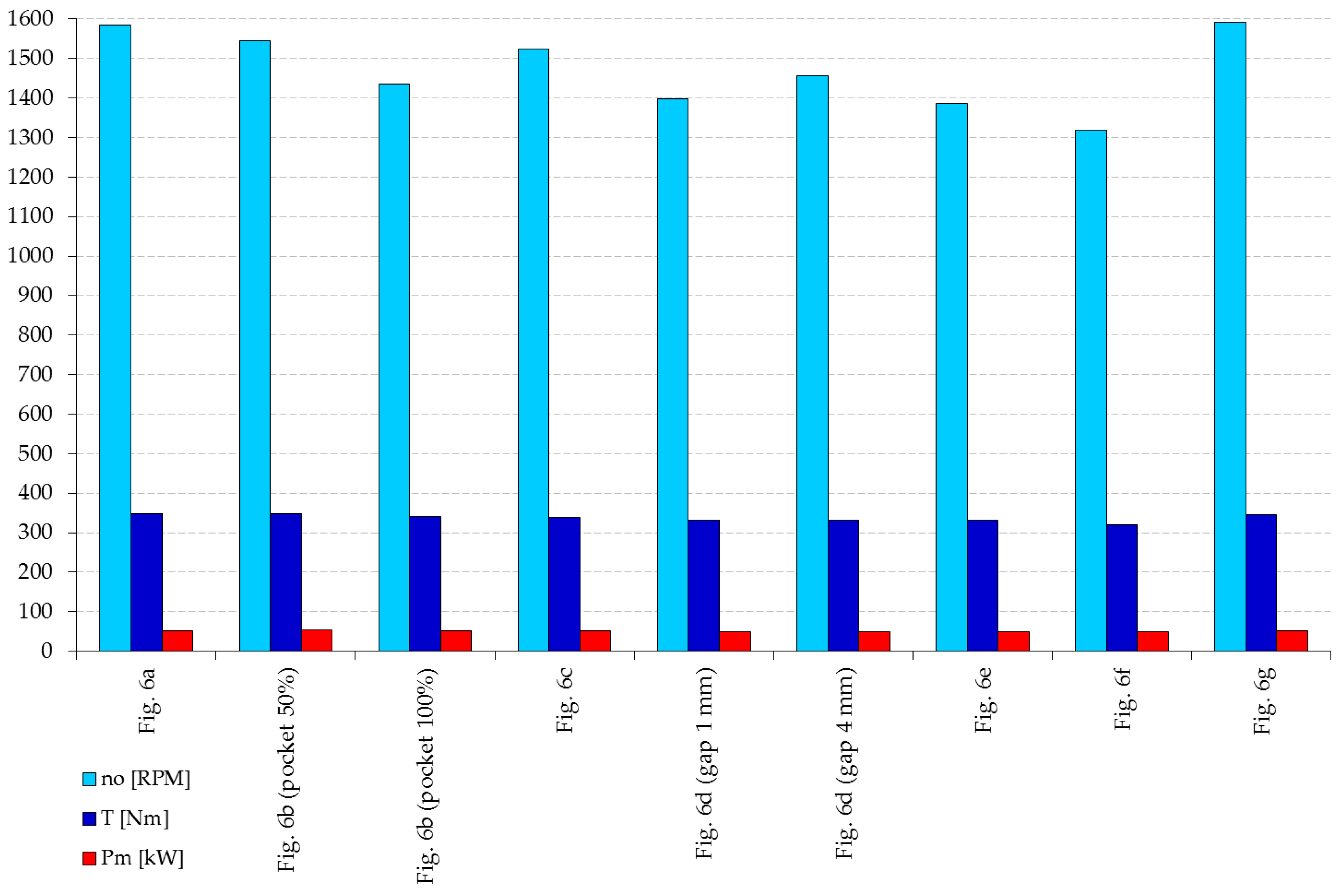
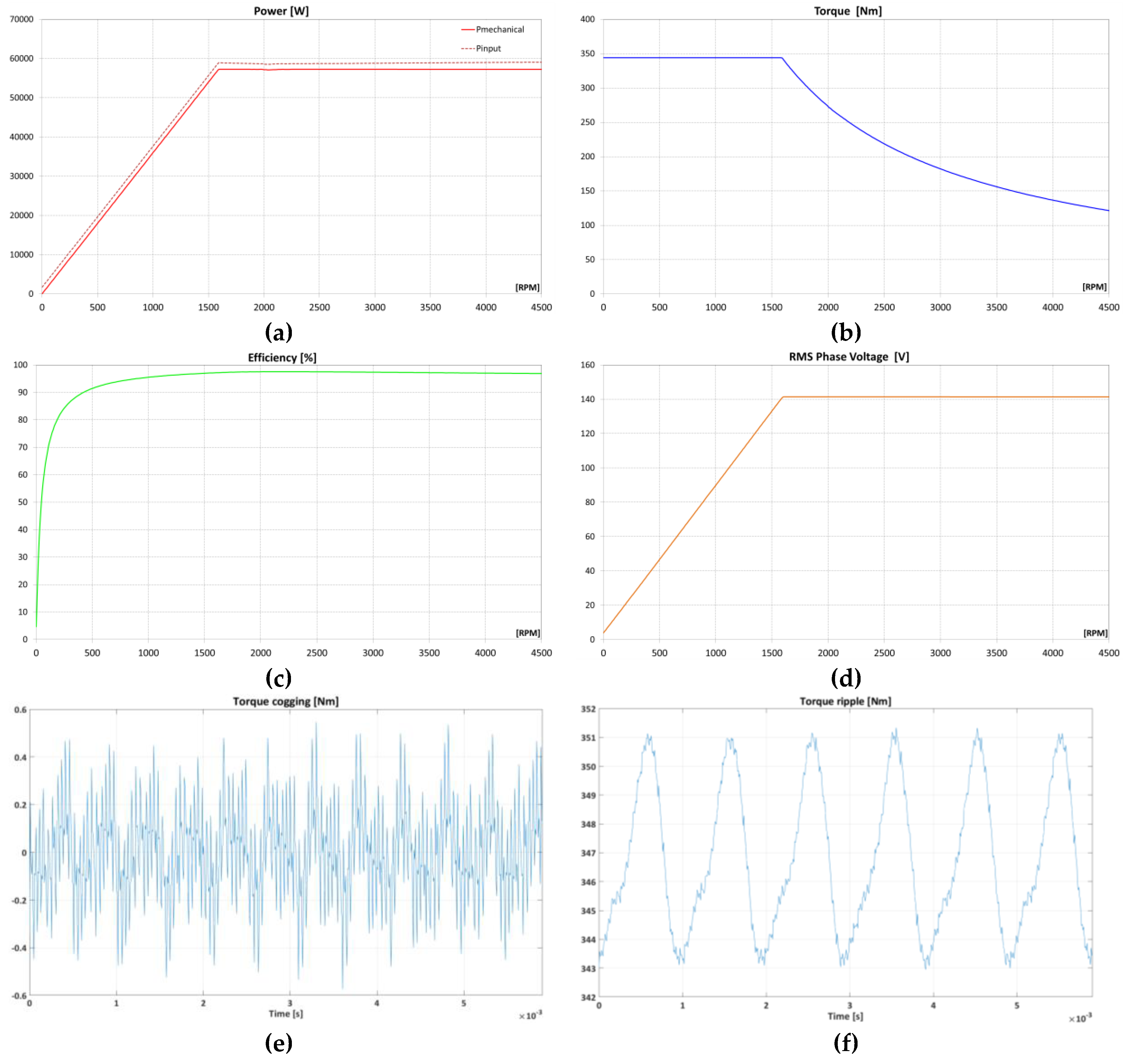
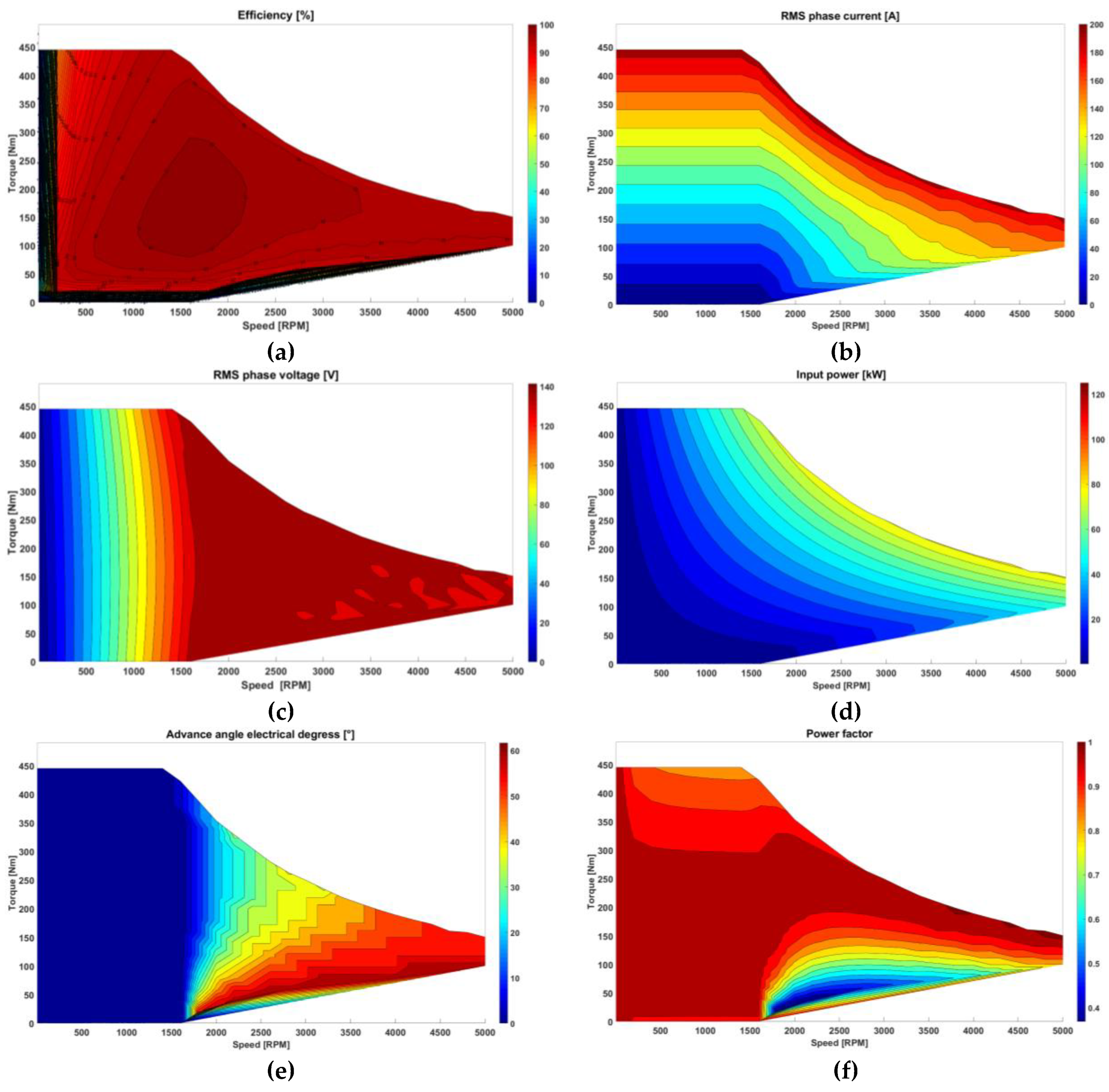
| Magnet shape (ref. Figure 6) | U (V) | URMS (V) | n0 (RPM) | T (Nm) | TP (Nm) | ηmax (%) | PM (kW) | PCu (kW) | PFe (kW) |
|---|---|---|---|---|---|---|---|---|---|
| Arc 4a, 66.7% | 141.4 | 123.3 | 1659 | 346 | 4.3 | 96.89 | 50.49 | 1.62 | 0.106 |
| Lenticular 4b, 66.7% | 141.4 | 119.7 | 1713 | 317 | 2.6 | 96.55 | 48.19 | 1.62 | 0.099 |
| Prismatic 4c, 66.7% | 141.4 | 122.3 | 1676 | 332 | 5 | 96.69 | 50.35 | 1.62 | 0.099 |
| Halbach 4d, 66.7% | 141.4 | 130.3 | 1570 | 360 | 6.8 | 97.11 | 54.67 | 1.62 | 0.113 |
| Magnet shape (ref. Figure 6) | U (V) | URMS (V) | n0 (RPM) | T (Nm) | TP (Nm) | ηmax (%) | PM (kW) | PCu (kW) | PFe (kW) |
|---|---|---|---|---|---|---|---|---|---|
| Arc 4a, 66.7% | 141.4 | 132.4 | 1549 | 352 | 4.5 | 96.76 | 53.42 | 1.68 | 0.107 |
| Lenticular 4b, 66.7% | 141.4 | 128.5 | 1595 | 336 | 2.7 | 96.62 | 50.96 | 1.68 | 0.101 |
| Prismatic 4c, 66.7% | 141.4 | 130.3 | 1573 | 351 | 5.3 | 97.37 | 53.27 | 1.68 | 0.100 |
| Halbach 4d, 66.7% | 141.4 | 139.9 | 1465 | 383 | 6 | 97.00 | 58.11 | 1.68 | 0.115 |
| Magnet Shape and Fill Percentage | U (V) | URMS (V) | n0 (RPM) | T (Nm) | TP (Nm) | ηmax (%) | PM (kW) | PCu (kW) | PFe (kW) |
|---|---|---|---|---|---|---|---|---|---|
| Arc 100°E, 55.6% | 141.4 | 122.8 | 1670 | 310 | 8.0 | 96.35 | 47.05 | 1.68 | 0.098 |
| Arc 110°E, 61.1% | 141.4 | 127.8 | 1601 | 332 | 8.7 | 96.58 | 50.44 | 1.68 | 0.103 |
| Arc 111°E, 61.7% (Golden Ratio) | 141.4 | 128.3 | 1598 | 335 | 8.5 | 96.61 | 50.82 | 1.68 | 0.104 |
| Arc 120°E, 66.7% | 141.4 | 132.4 | 1549 | 352 | 4.5 | 96.76 | 53.42 | 1.68 | 0.107 |
| Arc 130°E, 72.2% | 141.4 | 136.8 | 1499 | 369 | 10.0 | 96.9 | 56.07 | 1.68 | 0.111 |
| Arc 140°E, 77.8% | 141.4 | 140.7 | 1457 | 384 | 14.0 | 97.01 | 58.35 | 1.68 | 0.115 |
| Arc 150°E, 83.3% | 141.4 | 143.7 | 1424 | 396 | 11.8 | 97.09 | 60.12 | 1.68 | 0.118 |
| Arc 160°E, 88.9% | 141.4 | 145.9 | 1402 | 404 | 6.0 | 97.15 | 61.37 | 1.68 | 0.120 |
| Arc 170°E, 94.4% | 141.4 | 146.3 | 1398 | 407 | 20.0 | 97.16 | 61.81 | 1.68 | 0.121 |
| Description | U (V) | URMS (V) | n0 (RPM) | T (Nm) | TP (Nm) | ηmax (%) | PM (kW) | PCu (kW) | PFe (kW) |
|---|---|---|---|---|---|---|---|---|---|
| Lent. R62, 66.7% | 141.4 | 124.7 | 1644 | 319 | 1.4 | 96.46 | 48.41 | 1.68 | 0.097 |
| Lent. R112, 66.7% | 141.4 | 128.5 | 1595 | 336 | 2.7 | 96.62 | 50.96 | 1.68 | 0.101 |
| Lent. R282, 66.7% | 141.4 | 131.5 | 1559 | 348 | 3.8 | 96.73 | 52.83 | 1.68 | 0.104 |
| Description | U (V) | URMS (V) | n0 (RPM) | T (Nm) | TP (Nm) | ηmax (%) | PM (kW) | PCu (kW) | PFe (kW) |
|---|---|---|---|---|---|---|---|---|---|
| Flat 100°E, 55.6% | 141.4 | 119.9 | 1706 | 298 | 5.0 | 96.22 | 45.26 | 1.68 | 0.094 |
| Flat 110°E, 61.1% | 141.4 | 123.8 | 1653 | 317 | 2.9 | 96.44 | 48.19 | 1.68 | 0.096 |
| Flat 114.66, 63.7% | 141.4 | 125.4 | 1632 | 325 | 2.5 | 96.52 | 49.38 | 1.68 | 0.098 |
| Flat 120°E, 66.7% | 141.4 | 130.3 | 1573 | 351 | 5.3 | 97.37 | 53.27 | 1.68 | 0.100 |
| Flat 130°E, 72.2% | 141.4 | 130.1 | 1573 | 346 | 4.8 | 96.72 | 52.61 | 1.68 | 0.100 |
| Flat 140°E, 77.8% | 141.4 | 131.9 | 1559 | 356 | 5.4 | 96.80 | 54.00 | 1.68 | 0.101 |
| Flat 150°E, 83.3% | 141.4 | 132.4 | 1545 | 360 | 4.5 | 96.84 | 54.68 | 1.68 | 0.101 |
| Flat 160°E, 88.9% | 141.4 | 131.5 | 1556 | 359 | 2.7 | 96.84 | 54.56 | 1.68 | 0.100 |
| Flat 170°E, 94.4% | 141.4 | 129.5 | 1580 | 354 | 1.6 | 96.80 | 53.78 | 1.68 | 0.098 |
| Description | U (V) | URMS (V) | n0 (RPM) | T (Nm) | TP (Nm) | ηmax (%) | PM (kW) | PCu (kW) | PFe (kW) |
|---|---|---|---|---|---|---|---|---|---|
| Flat 120°E, 6 [mm] | 141.4 | 134.0 | 1527 | 313 | 5.1 | 96.38 | 47.56 | 1.68 | 0.104 |
| Flat 120°E, 8 [mm] | 141.4 | 132.1 | 1549 | 338 | 5.6 | 96.64 | 51.38 | 1.68 | 0.103 |
| Flat 120°E, 10 [mm] | 141.4 | 130.3 | 1573 | 351 | 5.3 | 97.37 | 53.27 | 1.68 | 0.100 |
| Flat 120°E, 12 [mm] | 141.4 | 126.3 | 1620 | 347 | 5.0 | 96.75 | 53.13 | 1.68 | 0.095 |
| Flat 120°E, 14 [mm] | 141.4 | 116.3 | 1759 | 322 | 4.3 | 96.51 | 48.90 | 1.68 | 0.085 |
| Description | U (V) | URMS (V) | n0 (RPM) | T (Nm) | TP (Nm) | ηmax (%) | PM (kW) | PCu (kW) | PFe (kW) |
|---|---|---|---|---|---|---|---|---|---|
| Ref. Fig. 6a | 141.4 | 129.4 | 1584 | 348 | 5 | 96.74 | 52.91 | 1.68 | 0.099 |
| Ref. Fig. 6b (recess depth 50%) | 141.4 | 132.7 | 1545 | 349 | 5 | 96.75 | 53.01 | 1.68 | 0.100 |
| Ref. Fig. 6b (recess depth 100%) | 141.4 | 142.9 | 1435 | 340 | 2.5 | 96.65 | 51.62 | 1.68 | 0.106 |
| Ref. Fig. 6c | 141.4 | 134.5 | 1524 | 338 | 2.5 | 96.65 | 51.41 | 1.68 | 0.101 |
| Ref. Fig. 6d (gap width 1 mm) | 141.4 | 146.6 | 1399 | 332 | 4 | 96.57 | 50.48 | 1.68 | 0.113 |
| Ref. Fig. 6d (gap width 4 mm) | 141.4 | 140.7 | 1457 | 332 | 4 | 96.57 | 50.36 | 1.68 | 0.108 |
| Ref. Fig. 6e | 141.4 | 147.9 | 1386 | 332 | 4 | 96.56 | 50.39 | 1.68 | 0.133 |
| Ref. Fig. 6f | 141.4 | 155.5 | 1318 | 319 | 1.8 | 96.40 | 48.49 | 1.68 | 0.092 |
| Ref. Fig. 6g | 141.4 | 128.9 | 1591 | 346 | 5 | 96.72 | 52.53 | 1.68 | 0.097 |
| Description | U (V) | URMS (V) | n0 (RPM) | T (Nm) | TP (Nm) | ηmax (%) | PM (kW) | PCu (kW) | PFe (kW) |
|---|---|---|---|---|---|---|---|---|---|
| M400–50A | 141.4 | 131.1 | 1564 | 351 | 5.5 | 96.65 | 53.35 | 1.68 | 0.168 |
| M350–50A | 141.4 | 131.2 | 1559 | 351 | 5.5 | 96.65 | 53.36 | 1.68 | 0.168 |
| M330–50A | 141.4 | 131.2 | 1563 | 352 | 5.6 | 96.68 | 53.39 | 1.68 | 0.150 |
| M330–35A | 141.4 | 131.2 | 1563 | 352 | 5.6 | 96.70 | 53.40 | 1.68 | 0.138 |
| M300–35A | 141.4 | 131.1 | 1561 | 351 | 5.4 | 96.74 | 53.33 | 1.68 | 0.117 |
| M270–35A | 141.4 | 131.0 | 1562 | 351 | 5.4 | 96.75 | 53.31 | 1.68 | 0.108 |
| M250–35A | 141.4 | 131.0 | 1562 | 351 | 5.3 | 96.76 | 53.29 | 1.68 | 0.105 |
| M235–35A | 141.4 | 130.3 | 1573 | 351 | 5.3 | 97.37 | 53.27 | 1.68 | 0.100 |
| Description | U (V) | URMS (V) | n0 (RPM) | T (Nm) | TP (Nm) | ηmax (%) | PM (kW) | PCu (kW) | PFe (kW) |
|---|---|---|---|---|---|---|---|---|---|
| 1010 AISI 0.1%C | 141.4 | 130.2 | 1575 | 349 | 5.2 | 96.75 | 53.00 | 1.68 | 0.099 |
| M400–50A | 141.4 | 128.4 | 1597 | 345 | 5.0 | 96.7169 | 52.3781 | 1.68 | 0.0960538 |
| M235–35A | 141.4 | 128.4 | 1597 | 345 | 5.0 | 96.7168 | 52.3791 | 1.68 | 0.0961179 |
| ARMCO | 141.4 | 130.3 | 1573 | 351 | 5.3 | 97.37 | 53.27 | 1.68 | 0.100 |
| Description | U (V) | URMS (V) | n0 (RPM) | T (Nm) | TP (Nm) | ηmax (%) | PM (kW) | PCu (kW) | PFe (kW) |
|---|---|---|---|---|---|---|---|---|---|
| N30UH | 141.4 | 123.6 | 1655 | 320 | 5.0 | 96.47 | 48.57 | 1.68 | 0.093 |
| N35UH | 141.4 | 128.3 | 1598 | 340 | 5.2 | 96.67 | 51.64 | 1.68 | 0.098 |
| N38UH | 141.4 | 130.3 | 1573 | 351 | 5.3 | 97.37 | 53.27 | 1.68 | 0.100 |
| N42UH | 141.4 | 133.9 | 1531 | 364 | 5.3 | 96.87 | 55.23 | 1.68 | 0.104 |
| N45UH | 141.4 | 136.0 | 1508 | 372 | 5.3 | 96.93 | 56.48 | 1.68 | 0.106 |
| Description | U (V) | URMS (V) | n0 (RPM) | T (Nm) | TP (Nm) | ηmax (%) | PM (kW) | PCu (kW) | PFe (kW) |
|---|---|---|---|---|---|---|---|---|---|
| Rotor skew 1° | 141.4 | 130.9 | 1566 | 350 | 4.0 | 96.76 | 53.23 | 1.68 | 0.100 |
| Rotor skew 2° | 141.4 | 130.6 | 1570 | 350 | 3.0 | 96.75 | 53.09 | 1.68 | 0.100 |
| Rotor skew 3° | 141.4 | 130.2 | 1575 | 348 | 1.5 | 96.74 | 52.86 | 1.68 | 0.099 |
| Rotor skew 3.25° | 141.4 | 130.0 | 1577 | 348 | 1.4 | 96.74 | 52.79 | 1.68 | 0.099 |
| Rotor skew 3.5° | 141.4 | 129.9 | 1578 | 347 | 0.9 | 96.73 | 52.72 | 1.68 | 0.098 |
| Rotor skew 3.75° | 141.4 | 129.8 | 1580 | 347 | 0.5 | 96.73 | 52.64 | 1.68 | 0.098 |
| Rotor skew 4° | 141.4 | 129.6 | 1582 | 346 | 0.7 | 96.72 | 52.55 | 1.68 | 0.098 |
| Rotor skew 5° | 141.4 | 128.9 | 1591 | 343 | 1.36 | 96.70 | 52.15 | 1.68 | 0.097 |
| Rotor skew 6° | 141.4 | 128.0 | 1602 | 340 | 1.4 | 96.67 | 51.66 | 1.68 | 0.095 |
| Rotor skew 7° | 141.4 | 127.0 | 1614 | 336 | 1.1 | 96.64 | 51.10 | 1.68 | 0.094 |
| Rotor skew 8° | 141.4 | 125.8 | 1630 | 332 | 1.03 | 96.00 | 50.45 | 1.68 | 0.092 |
| Rotor skew 9° | 141.4 | 124.5 | 1647 | 327 | 1.4 | 96.56 | 49.73 | 1.68 | 0.090 |
| Rotor skew 10° | 141.4 | 123.1 | 1666 | 322 | 1.3 | 96.51 | 48.93 | 1.68 | 0.088 |
| Description | U (V) | URMS (V) | n0 (RPM) | T (Nm) | TP (Nm) | ηmax (%) | PM (kW) | PCu (kW) | PFe (kW) |
|---|---|---|---|---|---|---|---|---|---|
| Stator skew 1° | 141.4 | 130.9 | 1566 | 350 | 4.0 | 96.76 | 53.23 | 1.68 | 0.100 |
| Stator skew 2° | 141.4 | 130.6 | 1570 | 350 | 3.2 | 96.75 | 53.10 | 1.68 | 0.100 |
| Stator skew 3° | 141.4 | 130.2 | 1575 | 348 | 1.5 | 96.74 | 52.87 | 1.68 | 0.099 |
| Stator skew 3.25° | 141.4 | 130.1 | 1576 | 348 | 1.3 | 96.74 | 52.81 | 1.68 | 0.099 |
| Stator skew 3.5° | 141.4 | 129.9 | 1578 | 347 | 0.9 | 96.73 | 52.73 | 1.68 | 0.098 |
| Stator skew 3.75° | 141.4 | 129.8 | 1580 | 347 | 0.6 | 96.73 | 52.65 | 1.68 | 0.098 |
| Stator skew 4° | 141.4 | 129.6 | 1582 | 346 | 1.2 | 96.72 | 52.57 | 1.68 | 0.098 |
| Stator skew 5° | 141.4 | 128.9 | 1591 | 344 | 1.3 | 96.70 | 52.18 | 1.68 | 0.097 |
| Stator skew 6° | 141.4 | 128.1 | 1597 | 340 | 1.57 | 96.67 | 51.71 | 1.68 | 0.096 |
| Stator skew 7° | 141.4 | 127.1 | 1610 | 337 | 1.16 | 96.64 | 51.16 | 1.68 | 0.094 |
| Stator skew 8° | 141.4 | 126.0 | 1624 | 333 | 0.94 | 96.60 | 50.53 | 1.68 | 0.093 |
| Stator skew 9° | 141.4 | 124.7 | 1641 | 328 | 1.41 | 96.56 | 49.82 | 1.68 | 0.091 |
| Stator skew 10° | 141.4 | 123.3 | 1659 | 323 | 1.40 | 96.49 | 49.04 | 1.68 | 0.089 |
| Description | U (V) | URMS (V) | n0 (RPM) | T (Nm) | TP (Nm) | ηmax (%) | PM (kW) | PCu (kW) | PFe (kW) |
|---|---|---|---|---|---|---|---|---|---|
| ERPMSM | 141.4 | 141.4 | 1550 | 347 | 0.6 | 96.73 | 57.2 | 1.68 | 0.098 |
© 2018 by the author. Licensee MDPI, Basel, Switzerland. This article is an open access article distributed under the terms and conditions of the Creative Commons Attribution (CC BY) license (http://creativecommons.org/licenses/by/4.0/).
Share and Cite
Łebkowski, A. Design, Analysis of the Location and Materials of Neodymium Magnets on the Torque and Power of In-Wheel External Rotor PMSM for Electric Vehicles. Energies 2018, 11, 2293. https://doi.org/10.3390/en11092293
Łebkowski A. Design, Analysis of the Location and Materials of Neodymium Magnets on the Torque and Power of In-Wheel External Rotor PMSM for Electric Vehicles. Energies. 2018; 11(9):2293. https://doi.org/10.3390/en11092293
Chicago/Turabian StyleŁebkowski, Andrzej. 2018. "Design, Analysis of the Location and Materials of Neodymium Magnets on the Torque and Power of In-Wheel External Rotor PMSM for Electric Vehicles" Energies 11, no. 9: 2293. https://doi.org/10.3390/en11092293





